Cellular communication even in the taiga: three generations of mobile base stations
Meet, you have three generations of our mobile base stations, which we have been designing on our own for almost 8 years! There are stations created on the basis of a large three-axle KAMAZ, there are “kids” based on the Ford Transit.
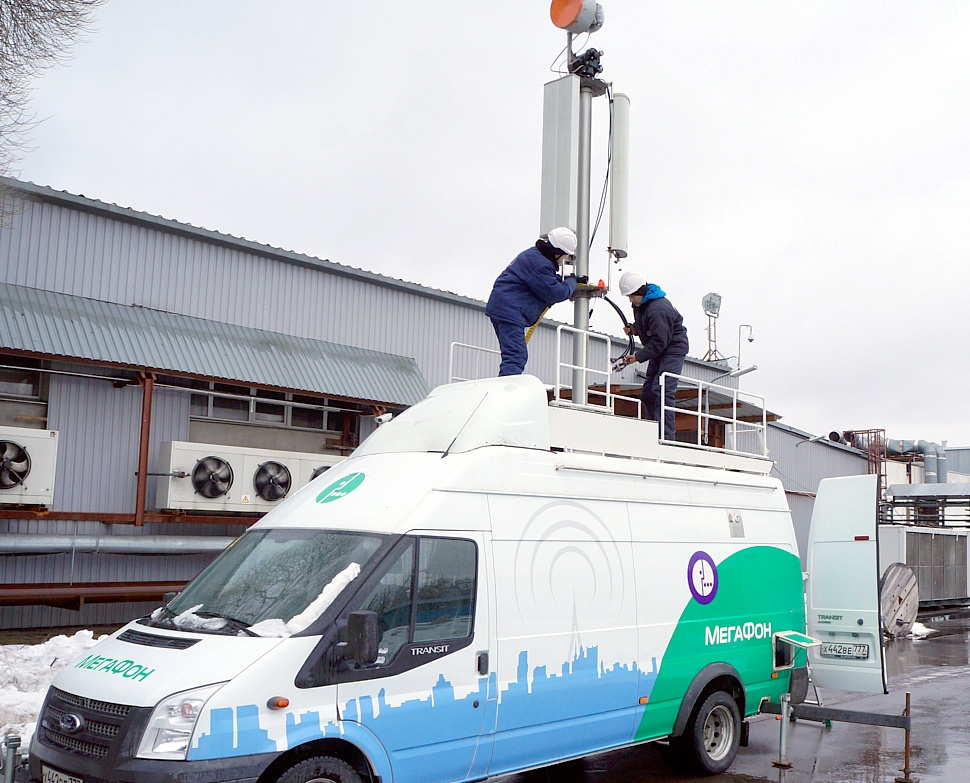
Their main purpose is to replace stationary BS during their repair. In addition, mobile base stations (PBS) are convenient to use in case of force majeure - for example, in case of natural disasters, fires, floods.
')
Want details - welcome under cat.

A third-generation mobile base station based on the Ford Transit minibus does not need a lot of space to deploy.
Another CBE is a good way to "secure" the main network in case of a temporary sharp increase in load - for example, during sports and public events or festivities. Although the operators and put in their networks excess capacity - just for such situations - it does not always save.
Accompanying various festive events is the lion’s share of all CBE trips, so the crews have appropriate “ceremonial-exit” clothing in case of duty of the deployed equipment. Most of these activities take place in the summer - then our crews have to make four to six trips a week.
Major annual holidays are included in the maintenance plan on an ongoing basis, and there are already prepared sites at the venue. Some of them are equipped with fixed antenna masts.
Mobile base station can not only increase the capacity of the cellular network in a particular location, but also improve its coverage or provide it in a new location. In such cases, it is usually placed temporarily, until a stationary BS appears at the desired point. In addition, we have a service in which anyone for a certain amount can order a BS for an event or to service company employees.
The group of mobile base stations of the metropolitan branch of MegaFon was established in 2010. The task of installing the base station on the wheels was initially non-trivial - there was no necessary experience in the company and it was necessary to go practically “in the virgin soil”.
The first sign was a complex based on a standard seven-ton car Iveco, the kung of which was equipped with GSM standard transceivers operating in the 900/1800 MHz bands. Later, with the start of mass construction of third-generation networks, the complex was supplemented with a 3G module and two masts for cellular and radio relay antennas.
The next generation is mobile complexes made on the basis of the KAMAZ-43118 chassis of all-terrain. Such a car can drive off-road to the most deaf and inaccessible places for normal transport.


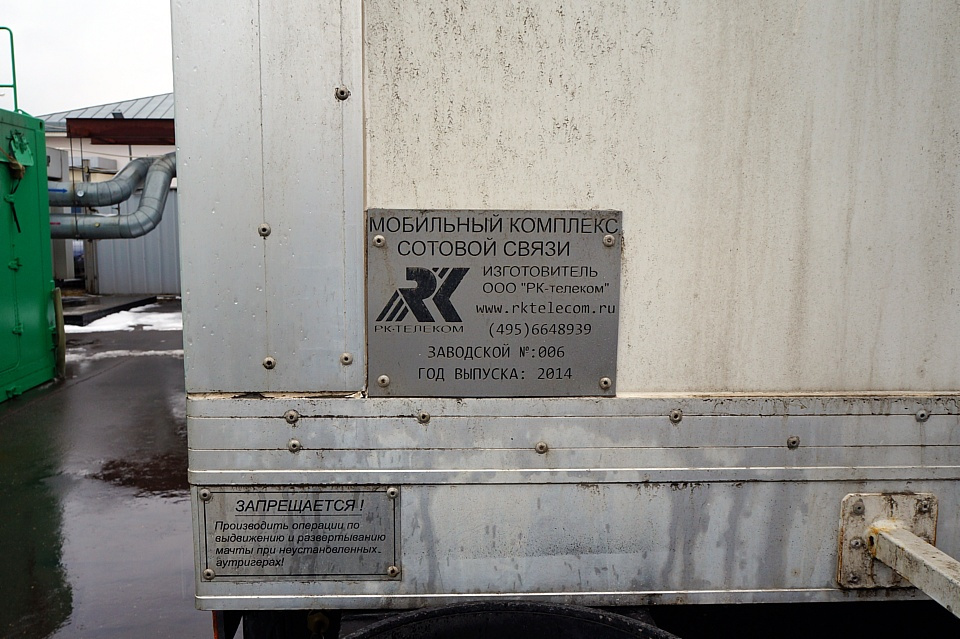
Mobile base station based on KAMAZ-43118 chassis
In the development of new systems, we took into account all the comments and nuances identified during the operation of the first PBS. The equipment room is equipped with everything necessary for all-season autonomous operation: heating and air-conditioning systems, cooking equipment and sleeping places for personnel.
Radio equipment consists of 2G / 3G / 4G + transceivers that can operate in the 900, 1800, 2100, 2600 MHz bands, which allows for both voice communication and high-speed mobile Internet.
The upgrade of the equipment of mobile BS occurs about once every six months. At the moment, it supports all bands and communication technologies allowed by the operator, including 4G / LTE.

"Stuffing" mobile complexes
The third generation of mobile base stations are complexes based on the Ford Transit minivan with a standard all-metal van. In contrast to the KAMAZ version, they do not require a special body, and the placement of equipment in it requires a minimum of modifications, not counting the fastener of the antenna mast. However, in order to increase stability, the car is equipped with fasteners for attachment stops. In addition, we had to radically rework the supply and exhaust air conditioning system, providing it with additional fans.
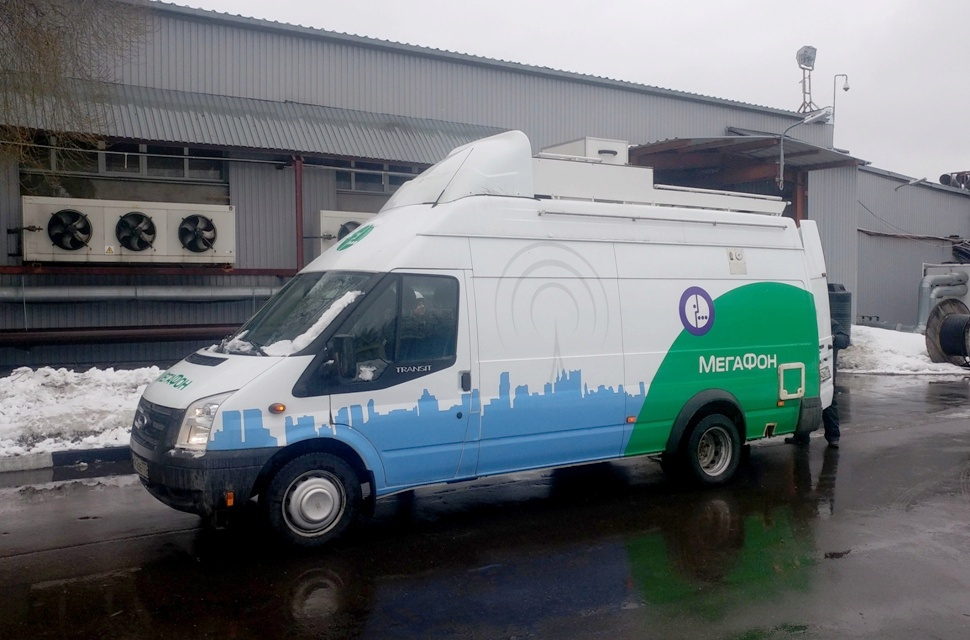
PBS third generation hiding inside a conventional Ford Transit minivan
Often we deploy a mobile base station away from any urban communications, including power networks. Therefore, each complex is equipped with a diesel generator, which provides all the equipment with autonomous power, including the antenna mast lifting mechanism.
For example, a 20.5-ton KAMAZ carries a 19 kW generator on its board. Its completely filled tank lasts for seven days of work far from stationary power supply lines. In addition, in the case of generation of fuel or stopping the generator, power can be supplied from lithium-ion batteries for seven hours.

Additional "electrical insurance" of the complex - the battery lasts for seven hours of battery life

A special electronic unit allows you to monitor various power sources and, if necessary, switch from one to the other.
All mobile communication systems currently available at MegaFon are equipped with telescopic retractable masts. Despite the large number of similar products on the market, there are no masts capable of withstanding the climatic conditions of central Russia. Constant fluctuations in temperature, moisture condensation inside the mechanism and its freezing lead to rupture of the southerners' pipes. Therefore, when creating the complex, we decided to give preference to the masts of Russian manufacturers.
In principle, there are masts with hydraulic and pneumatic lifting mechanism. In the first case, the compressor and the oil tank are used to extend the antenna. The total weight of this design together with the mast is 6 tons. Only the KAMAZ-based chassis can withstand such weight. In addition, these masts can be extended in height by no more than 15 meters and are capable of carrying a payload limited in weight, which sharply limits their use. Therefore, we definitely chose "pneumatics".

Folded 15-meter mast inside PBS container type

For mounting antennas in all mobile complexes of Megaphone, telescopic sliding pneumatic masts are used, which are cheaper and more economical than hydraulic ones and can carry up to 200 kg of payload.
The principle of operation of the pneumatic sliding mechanism is very simple. A special generator forces air into the knees, which are connected to each other by special cuffs with a hole. First, the thickest knee extends, and then, as the locking locks unfold, and all the rest.
To lift 200 kg, a pressure of no more than 1.7 atmospheres is sufficient. With a higher air pressure, the safety valve is activated.
The complex on the basis of KAMAZ uses a 30-meter mast, consisting of eight tribes. Such a high antenna allows you to provide coverage over a large area. This can be convenient in places with low density of installation of base stations. However, in the conditions of the city, in order not to interfere with the work of nearby BSs, it is possible to get by with shorter masts. In addition, for reliable fixation of the 30-meter mast requires fastening with the help of four tiers of delays and 12 one-and-a-half metal stakes, the drilling of which can lead to damage to the underground city communications.

Ford Transit-based mobile base stations are equipped with 12-meter masts that extend from the thin knee.
In winter, mast pipes require special antifreeze treatment that absorbs condensate.
True, pneumatic masts are not perfect. So, despite the use of cuffs, the air from the system slowly teasing. Therefore, we look at the masts of other structures. For example, now the option of using truss spans is being worked out - however, due to massiveness, they can be used only on KAMAZ trucks.
At first glance it may seem that it is easy to launch a mobile base station - drove the car to the right place, raised the antenna and work on your health. But, of course, in fact it is not.
The planning engineer, who determines which radio frequencies can be used in this particular place, is the first to go to the expected place of deployment of the base station, so as not to interfere subsequently with the equipment of other departments or other cellular operators, or with their base stations located nearby. ranges. He also decides how this station will be integrated into the general infrastructure of the operator. This may be, for example, a radio relay channel, a connection via copper or fiber optic cable or via satellite.
The next stage is the coordination of the required frequency parameters, transmitter power, antenna height and the installation site of the complex with regulatory bodies. It usually takes about a month, but in emergency situations such issues can be resolved much more quickly.
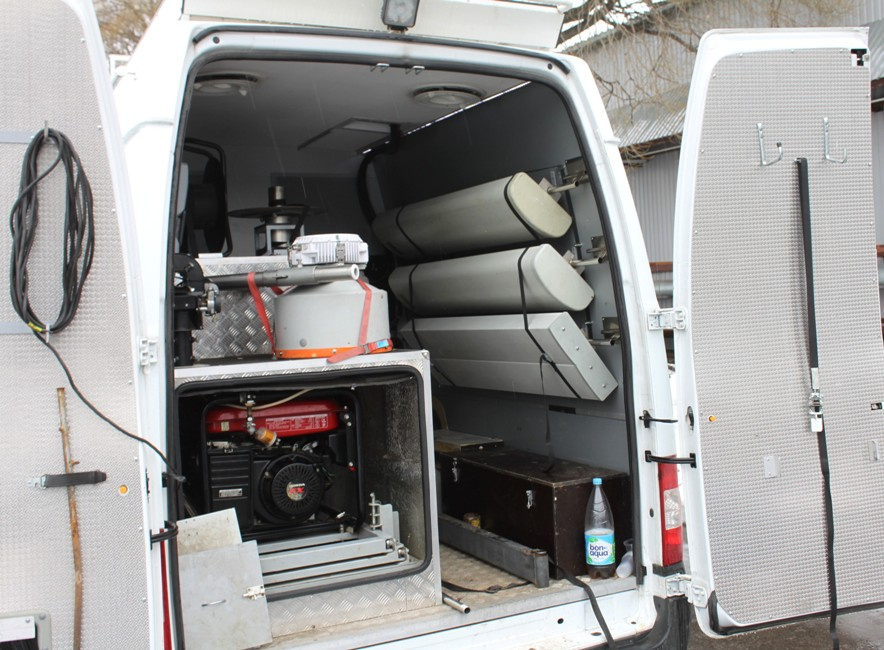
At the final stage before departure, the crew, based on the data received from the planning engineer, selects antennas and feeders for the ranges allowed for operation and adjusts all the equipment of the mobile base station
A mobile communications complex is usually deployed by two or three universal specialists within three to six hours.
Upon arrival, the place of the machine is leveled and fixed on the platform with the help of special stops, which give it the necessary stability.
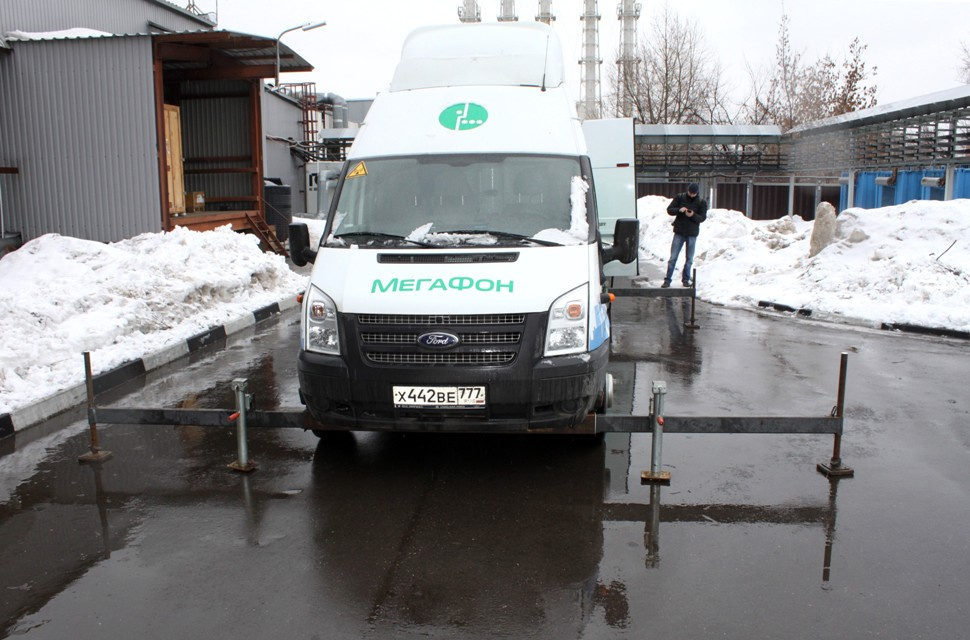
To give additional stability, the complex is fixed with the help of special stops.
Then the equipment is connected to the power supply - from the nearest network or generator, if it is not there. At the same time, GSM 900/1800, 3G 900/1800/2100 and LTE 1800/2600 cellular communication antennas are mounted on the mast, depending on the bands for which permission has been obtained from regulatory bodies.

Feeder lines must be connected to them before lifting antennas.


The extended mast must be secured with several rows of pulls.
To integrate the mobile base station into the operator’s infrastructure, it is required to organize a service communication line. For this purpose, protected copper cables (up to 150 meters in length), fiber optic channels, and radio relay communication lines are used. And due to the special satellite equipment, PBS is integrated into the MegaFon single infrastructure in hard-to-reach places far from other transport channels.

The least expensive and easiest way to organize a service line is the use of radio-relay channels, the data transfer rate in which can reach 1 Gbit / s. The main thing is that within the line of sight there is a stationary base station equipped with radio relay. An additional parabolic antenna of the mobile complex is sent to it.

Rack with equipment inside PBS based on Ford
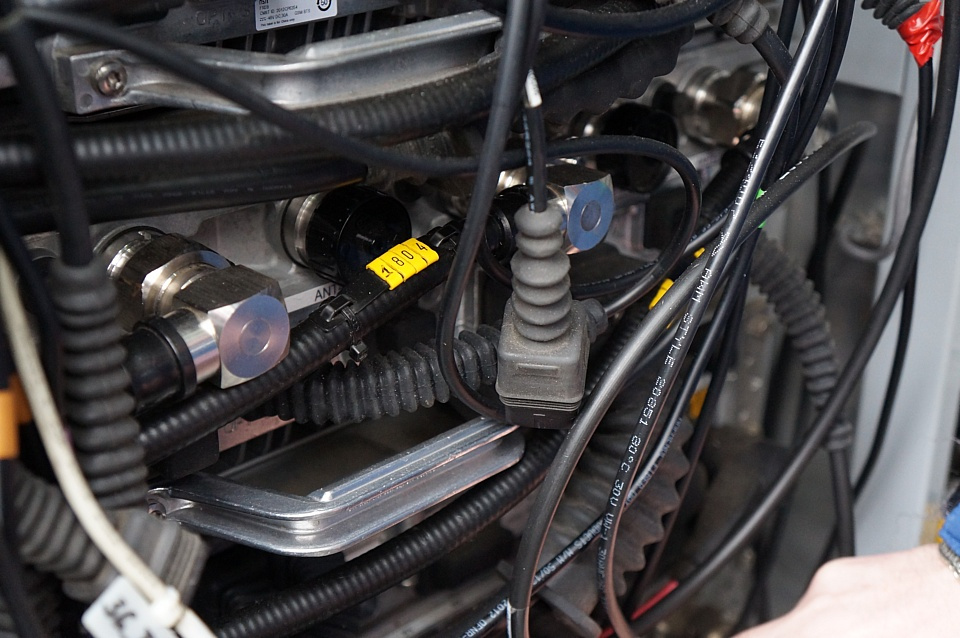
Having tuned the antennas, we proceed to the equipment setup. Yellow labels on the cable indicate the range of frequencies at the switches
A properly configured base station can provide voice communications and mobile Internet, depending on the bands used, from several hundred to several thousand subscribers at a distance of 5-25 kilometers.

Mobile base station in working condition
As practice shows, most of the time mobile complexes are carried out not in motion, but on stationary platforms. At the same time, for example, an application for the installation of such a station in the city needs to be submitted no less than in a month - therefore, it is often already known in advance where it will be necessary to deploy CBE.
Therefore, the line of MegaFon mobile stations has been replenished with a container variant, which can be quickly installed on a car chassis, transported to the right place and removed from the platform using a crane manipulator. So one car will be able to deliver several base stations.


The container is the same mobile base station with a retractable 15-meter mast, but without wheels. Folding paws provide additional stability.
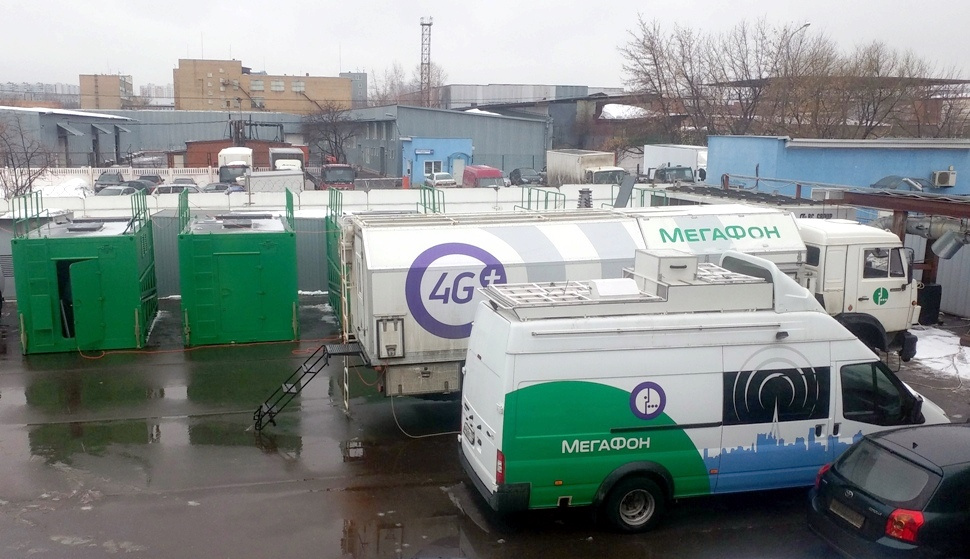
Park mobile base stations "Megaphone". There are 12 of them in the metropolitan area.
Now you are familiar with all types of our mobile stations. Their use is scheduled a year in advance, taking into account various events and activities. In the “hot seasons” in the Moscow region, there are up to five trips a week, not counting cases where mobile stations are set for a fairly long time. MFN officers, and sometimes even various power structures, unexpectedly wedge themselves up into harmonious plans more often. And here everything is clear - their work is not on schedule. But there are also commercial orders, and in view of the emergence of a noticeable demand, last year we even introduced the corresponding commercial service . So many companies may well use it and even be in the middle of the taiga in the “home region”.

Their main purpose is to replace stationary BS during their repair. In addition, mobile base stations (PBS) are convenient to use in case of force majeure - for example, in case of natural disasters, fires, floods.
')
Want details - welcome under cat.

A third-generation mobile base station based on the Ford Transit minibus does not need a lot of space to deploy.
Another CBE is a good way to "secure" the main network in case of a temporary sharp increase in load - for example, during sports and public events or festivities. Although the operators and put in their networks excess capacity - just for such situations - it does not always save.
Accompanying various festive events is the lion’s share of all CBE trips, so the crews have appropriate “ceremonial-exit” clothing in case of duty of the deployed equipment. Most of these activities take place in the summer - then our crews have to make four to six trips a week.
Major annual holidays are included in the maintenance plan on an ongoing basis, and there are already prepared sites at the venue. Some of them are equipped with fixed antenna masts.
Mobile base station can not only increase the capacity of the cellular network in a particular location, but also improve its coverage or provide it in a new location. In such cases, it is usually placed temporarily, until a stationary BS appears at the desired point. In addition, we have a service in which anyone for a certain amount can order a BS for an event or to service company employees.
From Iveco to Ford Transit
The group of mobile base stations of the metropolitan branch of MegaFon was established in 2010. The task of installing the base station on the wheels was initially non-trivial - there was no necessary experience in the company and it was necessary to go practically “in the virgin soil”.
The first sign was a complex based on a standard seven-ton car Iveco, the kung of which was equipped with GSM standard transceivers operating in the 900/1800 MHz bands. Later, with the start of mass construction of third-generation networks, the complex was supplemented with a 3G module and two masts for cellular and radio relay antennas.
The next generation is mobile complexes made on the basis of the KAMAZ-43118 chassis of all-terrain. Such a car can drive off-road to the most deaf and inaccessible places for normal transport.



Mobile base station based on KAMAZ-43118 chassis
In the development of new systems, we took into account all the comments and nuances identified during the operation of the first PBS. The equipment room is equipped with everything necessary for all-season autonomous operation: heating and air-conditioning systems, cooking equipment and sleeping places for personnel.
Radio equipment consists of 2G / 3G / 4G + transceivers that can operate in the 900, 1800, 2100, 2600 MHz bands, which allows for both voice communication and high-speed mobile Internet.
The upgrade of the equipment of mobile BS occurs about once every six months. At the moment, it supports all bands and communication technologies allowed by the operator, including 4G / LTE.

"Stuffing" mobile complexes
The third generation of mobile base stations are complexes based on the Ford Transit minivan with a standard all-metal van. In contrast to the KAMAZ version, they do not require a special body, and the placement of equipment in it requires a minimum of modifications, not counting the fastener of the antenna mast. However, in order to increase stability, the car is equipped with fasteners for attachment stops. In addition, we had to radically rework the supply and exhaust air conditioning system, providing it with additional fans.

PBS third generation hiding inside a conventional Ford Transit minivan
From power to mast
Often we deploy a mobile base station away from any urban communications, including power networks. Therefore, each complex is equipped with a diesel generator, which provides all the equipment with autonomous power, including the antenna mast lifting mechanism.
For example, a 20.5-ton KAMAZ carries a 19 kW generator on its board. Its completely filled tank lasts for seven days of work far from stationary power supply lines. In addition, in the case of generation of fuel or stopping the generator, power can be supplied from lithium-ion batteries for seven hours.

Additional "electrical insurance" of the complex - the battery lasts for seven hours of battery life

A special electronic unit allows you to monitor various power sources and, if necessary, switch from one to the other.
All mobile communication systems currently available at MegaFon are equipped with telescopic retractable masts. Despite the large number of similar products on the market, there are no masts capable of withstanding the climatic conditions of central Russia. Constant fluctuations in temperature, moisture condensation inside the mechanism and its freezing lead to rupture of the southerners' pipes. Therefore, when creating the complex, we decided to give preference to the masts of Russian manufacturers.
In principle, there are masts with hydraulic and pneumatic lifting mechanism. In the first case, the compressor and the oil tank are used to extend the antenna. The total weight of this design together with the mast is 6 tons. Only the KAMAZ-based chassis can withstand such weight. In addition, these masts can be extended in height by no more than 15 meters and are capable of carrying a payload limited in weight, which sharply limits their use. Therefore, we definitely chose "pneumatics".

Folded 15-meter mast inside PBS container type

For mounting antennas in all mobile complexes of Megaphone, telescopic sliding pneumatic masts are used, which are cheaper and more economical than hydraulic ones and can carry up to 200 kg of payload.
The principle of operation of the pneumatic sliding mechanism is very simple. A special generator forces air into the knees, which are connected to each other by special cuffs with a hole. First, the thickest knee extends, and then, as the locking locks unfold, and all the rest.
To lift 200 kg, a pressure of no more than 1.7 atmospheres is sufficient. With a higher air pressure, the safety valve is activated.
The complex on the basis of KAMAZ uses a 30-meter mast, consisting of eight tribes. Such a high antenna allows you to provide coverage over a large area. This can be convenient in places with low density of installation of base stations. However, in the conditions of the city, in order not to interfere with the work of nearby BSs, it is possible to get by with shorter masts. In addition, for reliable fixation of the 30-meter mast requires fastening with the help of four tiers of delays and 12 one-and-a-half metal stakes, the drilling of which can lead to damage to the underground city communications.

Ford Transit-based mobile base stations are equipped with 12-meter masts that extend from the thin knee.
In winter, mast pipes require special antifreeze treatment that absorbs condensate.
True, pneumatic masts are not perfect. So, despite the use of cuffs, the air from the system slowly teasing. Therefore, we look at the masts of other structures. For example, now the option of using truss spans is being worked out - however, due to massiveness, they can be used only on KAMAZ trucks.
From planning to integration
At first glance it may seem that it is easy to launch a mobile base station - drove the car to the right place, raised the antenna and work on your health. But, of course, in fact it is not.
The planning engineer, who determines which radio frequencies can be used in this particular place, is the first to go to the expected place of deployment of the base station, so as not to interfere subsequently with the equipment of other departments or other cellular operators, or with their base stations located nearby. ranges. He also decides how this station will be integrated into the general infrastructure of the operator. This may be, for example, a radio relay channel, a connection via copper or fiber optic cable or via satellite.
The next stage is the coordination of the required frequency parameters, transmitter power, antenna height and the installation site of the complex with regulatory bodies. It usually takes about a month, but in emergency situations such issues can be resolved much more quickly.
At the final stage before departure, the crew, based on the data received from the planning engineer, selects antennas and feeders for the ranges allowed for operation and adjusts all the equipment of the mobile base station
A mobile communications complex is usually deployed by two or three universal specialists within three to six hours.
Upon arrival, the place of the machine is leveled and fixed on the platform with the help of special stops, which give it the necessary stability.
To give additional stability, the complex is fixed with the help of special stops.
Then the equipment is connected to the power supply - from the nearest network or generator, if it is not there. At the same time, GSM 900/1800, 3G 900/1800/2100 and LTE 1800/2600 cellular communication antennas are mounted on the mast, depending on the bands for which permission has been obtained from regulatory bodies.

Feeder lines must be connected to them before lifting antennas.


The extended mast must be secured with several rows of pulls.
To integrate the mobile base station into the operator’s infrastructure, it is required to organize a service communication line. For this purpose, protected copper cables (up to 150 meters in length), fiber optic channels, and radio relay communication lines are used. And due to the special satellite equipment, PBS is integrated into the MegaFon single infrastructure in hard-to-reach places far from other transport channels.

The least expensive and easiest way to organize a service line is the use of radio-relay channels, the data transfer rate in which can reach 1 Gbit / s. The main thing is that within the line of sight there is a stationary base station equipped with radio relay. An additional parabolic antenna of the mobile complex is sent to it.

Rack with equipment inside PBS based on Ford

Having tuned the antennas, we proceed to the equipment setup. Yellow labels on the cable indicate the range of frequencies at the switches
A properly configured base station can provide voice communications and mobile Internet, depending on the bands used, from several hundred to several thousand subscribers at a distance of 5-25 kilometers.

Mobile base station in working condition
From platform to container
As practice shows, most of the time mobile complexes are carried out not in motion, but on stationary platforms. At the same time, for example, an application for the installation of such a station in the city needs to be submitted no less than in a month - therefore, it is often already known in advance where it will be necessary to deploy CBE.
Therefore, the line of MegaFon mobile stations has been replenished with a container variant, which can be quickly installed on a car chassis, transported to the right place and removed from the platform using a crane manipulator. So one car will be able to deliver several base stations.


The container is the same mobile base station with a retractable 15-meter mast, but without wheels. Folding paws provide additional stability.

Park mobile base stations "Megaphone". There are 12 of them in the metropolitan area.
Now you are familiar with all types of our mobile stations. Their use is scheduled a year in advance, taking into account various events and activities. In the “hot seasons” in the Moscow region, there are up to five trips a week, not counting cases where mobile stations are set for a fairly long time. MFN officers, and sometimes even various power structures, unexpectedly wedge themselves up into harmonious plans more often. And here everything is clear - their work is not on schedule. But there are also commercial orders, and in view of the emergence of a noticeable demand, last year we even introduced the corresponding commercial service . So many companies may well use it and even be in the middle of the taiga in the “home region”.
Source: https://habr.com/ru/post/328446/
All Articles